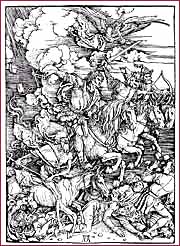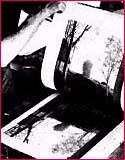|

Illustration #1

Illustration #2

Illustration #3
|
|
The Original
Print
(© Copyright 2001 Gerhard Wurzer Gallery, Houston Texas, USA)
What is an original print? The Print Council of America issued
a guide establishing a criteria for an original print:
1.The artist alone must create the master image on
the stone, or whatever material would be used to make the
print.
2. The print -if not printed by the artist- should
be hand printed by someone under the artist's direct supervision.
3. Each impression should be approved and signed by
the artist and the master image (the matrix) destroyed or
cancelled. The original print is not a copy of anything else,
not a copy of a painting or another print. If an artist chooses
to copy his own work, originally done in another medium, it
would be a print done after an oil (or other medium). An original
print is a creative endeavor by the artist and therefore is
as valid an expression as is any other form of visual art
- may it be a painting or a sculpture. The original print
is a work of art in it's own right.
The following information will help to clarify some of the
terminology that is associated with print collecting, which
may be somewhat intimidating.
Types of Prints
Many of the most famous images in art
are, in fact, prints. Take for example one of Durer's most
famous works "Apocalypse" (Ill. 1) which is a woodcut, and
therefore a multiple original. There are three "generalities"
of printmaking: relief methods, planographic methods, and
intaglio methods.
Relief
Prints
1.
The Woodcut
The technique for making woodcuts by the relief process was
discovered by the Chinese. It is the oldest form of printmaking,
and appeared in about a millenia before the first prints ever
appeared in €pe. Most artists in the 13th and 14th century
who made woodcuts remain anonymous. The first major artist
to use the medium was Albrecht Durer, who in 1498 executed
the large passion with German and Latin text.
The principal of the woodcut is similar to the workings of
a rubber stamp. The artist cuts away the portion of those
areas on the woodblock which he does not want to print leaving
raised (or in relief) the images that is to be printed.
2. Linoleum Cut
This method is done in much the same was as the woodcut, except
a linoleum block is used. (The most important Linoleum Cuts
were executed by Picasso, who invented a new "reduction" method.)
Planographic Methods
1. Lithograph
The artist draws the image directly on a highly polished limestone
using a grease based crayon, or grease based liquid called
tusche, similar to a paint (see Ill. 2). The stone is then
prepared for printing by applying a chemical solution of gum
arabic and nitric acid to make it more receptive to water.
In order to make the print, the stone is dampened with water,
which will not adhere to the image drawn because of the natural
antipathy of grease to water. When ink is rolled over the
stone, it will only adhere to the grease based image. Then
the paper is pressed against the stone, and only the ink on
the greasy image is transferred (see Ill. 3). The create a color lithograph,
a seperate stone for each color is used and must be printed
separately.
2. Serigraph
The artist prepares a screen of silk, or synthetic, in which
all areas other then the one that is to be printed is blocked
out. Paper is placed under the stencil and ink is forced through.
For each color a seperate screen in prepared.
Intaglio
Methods
Since the beginning of history, men scratched and incised
lines into stone, skin or bark. The technique was continued
by Greek designers and by the Etruscans and Romans. It was
brought to great refinement by the artisan-engraver, and that
of the artist, collaborating to produce a multiple image:
the print.
The apparently were in the beginning of the 16th century some
artist who felt that the woodcut was coarse and primitive.
We do not know who first thought of the idea of rubbing ink
into the lines and coaxing it out by pressing a dampened sheet
of paper against the metal surface.
The areas to be printed are incised by cutting, scratching,
or etching below the printing surface to hold ink in the now
recessed areas. The paper is placed on top of the plate and
together they are pulled through the press. The pressure required
to pick up the ink leaves a visable plate mark within the
margin of the sheet of paper.
1. Engraving
The design in cut into the surface of the matrix (commonly
a copper plate) by a tool called a burin. After inking, the
plate surface is whiped clean and the ink remains in the incised
lines.
2. Drypoint
The image is drawn onto the plate with a steel needle. The
incising leaves a ridge called a "burr", much like a plow
leaves furrows of dirt to either side as it cuts through the
ground. When the plate is printed, the burr holds some ink,
and produces a soft velvety line, characteristic of the Drypoint.
3. Etching
The artist coats the surface of the metal plate (usually copper)
with an acid-resistant ground. Then, with a needle, the artist
draws the image into the ground exposing the copper below.
The plate is then immersed in an acid bath which cuts lines
("biting") into the plate. After the plate is bitten to the
artist's satisfaction, it is cleaned, inked and printed.
4. Soft Ground Etching
The artist prepares the plate in much the same was as an etching,
using a different kind of ground. This ground allows the artist,
after laying a pice of paper on top, to draw the image with
a pencil. The coating under the pressure of the pencil adheres
to the paper which is then lifted off, exposing the copper
underneath. The plate is then bitten in the same way as an
etching.
5. Mezzotint
The plate surface is pitted with a tool called a raker. The
plate is eventually covered with thousands of tiny "pits"
which hold ink and would print a deep velvety black if not
further worked. The artist then scrapes and burnishes areas
of the plate he wishes to print less darkly, so the effect
is of tone rather than line. The artist essentially draws
the light into the image.
6. Aquatint
This technique is used to create tone and texture in a print.
The plate is sprinkled with a powdered resin, heated so the
resin melts and clings, then given an acid bath to bit the
areas not covered by the resin, creating a porus ground. Aquatint
is rarely employed by itself, but rather in combination with
other intaglio methods.
Common
Print Terms
A.P. - Impressions for the use of the artist outside
of the regular edition. (Artist Proof)
(Also E.A. - Epreuve d'Artiste)
a la poupee - A process by which all colors are applied
to the plate and printed simultaneously, creating varying
impressions.
bon a tire - Meaning "right to print" this impression
serves as a guide for the rest of the edition.
Cancelled Plate - The plate is holed or scratched over
in order to prevent further printing.
Catalogue Raisonne - A catalog containing a description
of all the work done by an artist.
Counter Proof - The artist places a piece of paper
over a print while the ink is still wet, and pulls another
impression from the print itself.
Edition and Edition Size - A completed run of prints
is usually limited. There appears to be no minimum or maximum
number used. Editions of 100 or less are considered small.
Orignal prints have been executed to accompany written texts
and such editions may number in the thousands.
Hand Signing and Numbering - A print does not have
to be signed and numbered to be an original. The practice
did not start until the later part of the 19th century. One
of the earliest proponents of the practice was Whistler. The
signature usually appears on the lower right margin and the
numbers on the left.
Signed in the Plate - Instead of signing each print
in pencil, the artist signs in the plate in which case the
signature appears printed.
State - A state designates an alteration on the plate,
however small or insignifigant it may be. The French engraver
Felix Buhot, for instance, seems to have been more concerned
about the changes he could affect by altering the plate rather
than the final or published state.
|